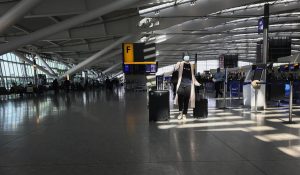The Latest
Experts: State on brink of a severe flareup that rivals initial coronavirus peak in spring
Illinois’ coronavirus testing positivity rate inched up for a 13th consecutive day Saturday as 3,629 more residents tested positive for COVID-19.
That’s almost a thousand fewer cases than the record-breaking tally of 4,554 announced by public health officials a day earlier, but it’s still the state’s fourth highest count of the pandemic.
Experts warn Illinois is on the brink of a severe coronavirus flareup rivaling its initial peak of the pandemic in May, as cases also soar to record highs in neighboring Midwest states. Illinois has logged almost 47,000 cases so far in October, more than double its figure for the entire month of June.
While hefty case numbers don’t tell the full story, the latest cases were confirmed among 77,489 tests, raising the statewide seven-day average testing positivity rate once again to 5.2%.
That number indicates how rapidly the virus is spreading, and it’s as high as it’s been since early June, shooting up nearly two full percentage points since Oct. 4.
“We’re in a new wave of COVID-19: rising cases, rising positivity, all across the nation — not just Illinois,” Gov. J.B. Pritzker said Friday.
News
8:15 a.m. US resorts adapt to new normal of skiing amid coronavirus pandemic
Helmet, goggles, skis? Check. Hand sanitizer, face covering, reservation? Check.
Roughly seven months after the coronavirus cut the ski season short at the height of spring break, resorts across the United States and Canada are slowly picking up the pieces and figuring out how to safely reopen this winter. While many of the details are still being worked out, resort leaders are asking guests to curb their expectations and to embrace a new normal while skiing and snowboarding amid a pandemic.
That could mean wearing masks, standing 6 feet (1.8 meters) apart in lift lines (about the length of a typical ski), no dine-in service, riding lifts only with your group and no large gatherings for an apres drink.
7:50 a.m. Trump demonstrates new determination to minimize threat of COVID-19
Gone are the days when President Donald Trump held forth daily at the White House podium flanked by members of his coronavirus task force. And the days when Vice President Mike Pence and other task force officials would head to Trump’s office to brief him immediately after their meetings.
The White House won’t say when Trump last met with the task force.
In the week since he emerged from coronavirus isolation, Trump has demonstrated new determination to minimize the threat of the virus that has killed more than 215,000 Americans and complicated his chances of winning another four years in the White House.
7:05 a.m. Doctors in rural Midwest struggle as COVID-19 overwhelms communities with limited resources
WESSINGTON SPRINGS, S.D. — Rural Jerauld County in South Dakota didn’t see a single case of the coronavirus for more than two months stretching from June to August. But over the last two weeks, its rate of new cases per person soared to one of the highest in the nation.
“All of a sudden it hit, and as it does, it just exploded,” said Dr. Tom Dean, one of just three doctors who work in the county.
As the brunt of the virus has blown into the Upper Midwest and northern Plains, the severity of outbreaks in rural communities has come into focus. Doctors and health officials in small towns worry that infections may overwhelm communities with limited medical resources. And many say they are still running up against attitudes on wearing masks that have hardened along political lines and a false notion that rural areas are immune to widespread infections.
Dean took to writing a column in the local weekly newspaper, the True Dakotan, to offer his guidance. In recent weeks, he’s watched as one in roughly every 37 people in his county has tested positive for the virus.
It ripped through the nursing home in Wessington Springs where both his parents lived, killing his father. The community’s six deaths may appear minimal compared with thousands who have died in cities, but they have propelled the county of about 2,000 people to a death rate roughly four times higher than the nationwide rate.
New cases
Analysis & Commentary
7:48 a.m. You don’t need a sleeping bag to survive early voting lines, but a campstool — and a scarf — might come in handy
It took me two hours and seven minutes to early vote this week at Truman College in Uptown, only five minutes of which involved actually filling out the ballot.
The rest of the time was spent waiting outdoors in a long line that moved at a glacial pace, followed by a shorter wait indoors.
Yes, this is why I should have taken the advice to vote by mail, but I wasn’t ready to do that, and only my wife gets to say, ‘I told you so,’ because she really did tell me so, and the rest of you were just thinking it.
In my defense, I’m hardly alone.
At numerous early voting sites across the city on Wednesday, voters experienced similar delays as the first day of expanded early voting in all 50 wards coincided with warm, sunny fall weather.
If you’re going to vote in person in 2020, you’re going to need to bring your patience, your mask, some comfortable shoes and probably your mobile phone to keep you entertained.
And, oh yes, appropriate outerwear because you’re going to be waiting outdoors. The pandemic requires election officials to limit the number of people inside a polling place.
In certain extreme circumstances, I could even see a campstool and snacks coming in handy.



















